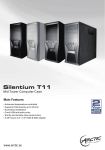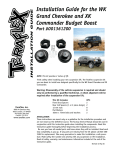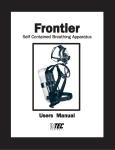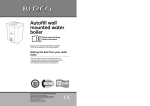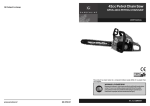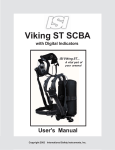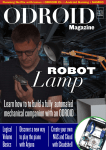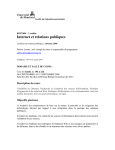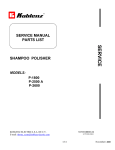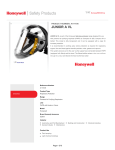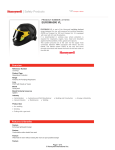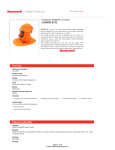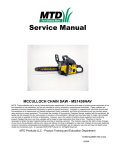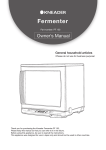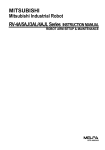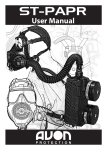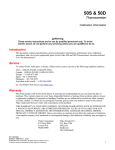Download FRONTIER® Series Self-Contained Breathing Apparatus User`s
Transcript
FRONTIER® Series Self-Contained Breathing Apparatus User’s Instructions North Safety Products 2000 Plainfield Pike Cranston, RI 02921 USA North Safety Products 10550 Parkway Blvd. Anjou, Quebec Canada H1J2K4 North Safety Products Noordmonsterwegl 4332 Sc Middleberg The Netherlands Telephone 800 430-4110 Telephone 888 212-7233 Facsimile 800 572-6346 Facsimile 5140355-7233 www.northsafetyproducts.com Telephone +31 (0) 118656400 Telephone +31 (0) 118627535 ©2006 North Safety Products Part No. 46001635 Rev. * 084112 Rev. A / A49222 Rev. A Printed in U.S.A. CONTENTS 1 1.1 1.1.1 1.1.2 1.1.3 1.1.4 1.1.5 1.1.6 1.2 1.3 1.4 2.0 2.1 2.2 2.3 2.4 2.5 2.6 2.7 3.0 3.1 3.2 3.3 4.0 4.1 4.2 5.0 5.1 5.1.3 5.1.4 5.2 6.0 6.1 7.0 7.1 7.2 8.0 8.1 9.0 9.1 9.2 9.2.1 9.2.2 9.3 9.4 10.0 10.1 10.2 10.3 11.0 12.0 13.0 PAGE NUMBER INTRODUCTION IMPORTANT INFORMATION TERMINOLOGY GENERAL WARNINGS HEALTH LIMITATIONS TRAINING PROGRAM FIT TESTING USER SEAL CHECKS SERVICE DURATION CAUTIONS AND LIMITATIONS SPECIAL AND CRITICAL USERS’ INSTRUCTIONS DESCRIPTION OF FRONTIER SCBA FACEPIECE COMPACT DEMAND VALVE (CDV) FIRST STAGE PRESSURE REDUCER REMOTE CYLINDER PRESSURE AND END-OF-SERVICE TIME INDICATORS BACKFRAME AND HARNESS CYLNDER AND VALVE ASSEMBLY FRONTIER CYLINDER TABLE ROUTINE CHECKS UNPACKING INVENTORY AND EXAMINATION ROUTINE CHECKS AND INSPECTIONS PUTTING ON THE RESPIRATOR AND SAFETY CHECKS PUTTING ON THE RESPIRATOR SAFETY CHECKS DURING USE NORMAL USE INSTRUCTIONS FOR CHANGING CYLINDERS CYLINDER BAND ADJUSTMENT EMERGENCY EGRESS INDICATORS AFTER USE PROCEDURES REMOVING THE SCBA AFTER USE CLEANING CLEANING THE FACEPIECE AND HOOD CLEANING THE BACKFRAME & HARNESS ASSEMBLY SCBA STORAGE SCBA STORAGE USER MAINTENANCE CYLINDER FILLING PROCEDURES FACEPIECE DISASSEMBLY & REASSEMBLY DISASSEMBLE FACEPIECE REASEMBLE FACEPIECE REPLACING FACEPIECE HEADSTRAP BACKFRAME HARNESS FRONTIER OPTIONS AIRLINE EMERGENCY AIRLINE SYSTEM (AES) FIRST BREATH (CDV) TROUBLE SHOOTING GUIDE MAJOR COMPONENTS FRONTIER WARRANTY KEY TO CAUTIONS AND LIMITATIONS CONTAINED IN THE NIOSH APPROVAL LABELS NIOSH APPROVAL LABEL. 2 3 3 3 4 4 5 5 5 5 6 6 8 8 9 9 9 9 9 10 10 10 10 10 12 12 13 14 14 15 15 15 16 16 16 16 17 18 18 18 18 19 19 19 20 20 20 20 21 22 22 22 23 1.0 INTRODUCTION These instructions are for the North Frontier Series Self-Contained Breathing Apparatus, an open circuit self-contained, pressure demand, compressed air breathing apparatus. The Frontier Series was designed to provide essential respirable air and adequate respiratory protection in both toxic and oxygen deficient atmospheres. The North Frontier Series respirator consists of a cylinder, backframe and harness assembly, and full facepiece or hood. These respirators are approved by the National Institute of Occupational Safety and Health (NIOSH). Positive pressure is maintained within the facepiece during use, thus providing the highest degree of respiratory protection in irrespirable atmospheres by preventing any inward leakage. The Frontier series includes SCBA units having a NIOSH 60 minute duration, units having a NIOSH 45 minute duration, and units having a NIOSH 30 minute duration. The North Frontier Series are also certified by NIOSH as Pressure Demand, Type C, Supplied Air Respirators when supplied with breathing air from a remote source, and equipped with the appropriate quick-connect couplers. 1.1 IMPORTANT INFORMATION This Users’ Instructions contains important information and must be read and understood by all persons who may use or maintain this apparatus. 1.1.1 TERMINOLOGY NOTE Procedures and techniques that are considered important enough to emphasize. CAUTION Procedures and techniques which, if not carefully followed, will result in damage to the equipment. WARNING Procedures and techniques which, if not carefully followed, will expose the user to the risk of serious injury, illness or death. Warnings, cautions and notes used in these instructions have the following significance: 3 WARNING Improper Use of Your Respirator Can Be Harmful or Deadly! For Your Safety, Read and Follow These Directives. If You Do Not Understand Them—Ask Your Supervisor! 1. Failure to follow North’s instructions and warnings, may result in exposure to the hazardous materials, exposing the user to the risk of serious injury, illness or death. 3. • • • • • • NEVER use your respirator: To perform or observe sand-blasting/abrasive-blasting; To fight fires; In temperatures below -25˚ F (-30˚ C); Without a fully charged cylinder; While working alone, except for escape; When the atmospheric pressure is below 450mm (17.7 in) mercury. 4. • • • • NEVER use your respirator if you cannot achieve a good facepiece-to-face seal due to: Facial hair; Eye wear that interferes with facepiece-to-face seal; Head or face coverings that interfere with sealing area; or Missing teeth, dentures, facial deformities or deep scars. 5. • • • • • IMMEDIATELY leave work area and remove respirator if: Breathing becomes difficult; You become dizzy or disoriented; You no longer have a good facepiece-to-face seal; You smell, taste or otherwise sense contaminants; or Your respirator is damaged. 6. REMEMBER: • Your respirator will not protect exposed areas of face or body from gases, vapors or airborne particles that can irritate, burn or be absorbed through your skin—wear hand and/or body protection. 1.1.2 GENERAL WARNINGS 1.1.3 HEALTH LIMITATIONS You should be certified medically fit prior to using this respirator. In addition there are both physiological and psychological limitations which should be considered before using an SCBA. They include, but are not limited to: a. Emphysema b. Chronic obstructive pulmonary disease c. Bronchial asthma d. X-ray evidence of pneumoconiosis e. Evidence of reduced pulmonary function 4 f. g. h. i. j. k. l. m. n. o. Coronary artery disease Severe or progressive hypertension Neurological conditions Anemia, pernicious Diabetes, insipidus or mellitus Breathing difficulty when wearing an SCBA Claustrophobia or anxiety when wearing an SCBA Abnormal EKG results from resting, or stress tests Punctured or ruptured ear drum Medications 1.1.4 TRAINING PROGRAM These brief written instructions cannot substitute for a formal Respirator Training Program. Training should be performed with a Safety Manager to ensure you are trained in the proper use of respirators, including putting on and removing them. Your training should include an opportunity for you to handle the respirator, learn how to inspect it, have it properly fitted, test its facepiece-to-face seal and wear it in an area with uncontaminated air while becoming familiar with it. You must inspect the respirator before and after each use to ensure that it is in good working condition. Training Programs in the U.S. should be based on ANSI Z88.2-1992, OSHA Regulation 29CFR Section 1910.134 and other regulations promulgated by various Regulatory Authorities. In Canada, the training program should be based on CSA Standard Z94.4-93. 1.1.5 FIT TESTING Before you are assigned a respirator with a tight fitting facepiece, you should have a qualitative or quantitative fit test to make sure it fits correctly. Ask your supervisor about these fit tests. The North Frontier Series is approved with North facepieces and hoods in sizes small and medium/large. Most faces can be fit with the medium/large; however some persons with small faces may get a better fit with the small. In addition, if your respirator has a tight fitting facepiece, you should be fit-tested at least once a year or any time there are changes that may affect the fit of the respirator, such as weight changes or dental surgery. A quantitative fit test adapter (North catalog number 900099) is available for conducting fit tests. Instructions for fit testing are given in OSHA 29 CFR §1910.134 Appendix A, and respirator manuals published by government agencies such as NIOSH, ERDA, and NRC. 1.1.6 USER SEAL CHECKS Each time that the respirator is put on, and before each entry into a contaminated atmosphere, the respirator wearer should check the effectiveness of the seal of the facepiece to the wearer’s face by carrying out a user seal check. Instructions for carrying out user seal checks on this respirator are given in Section 4.2.1 of these User’s Instructions. 1.2 SERVICE DURATION The Frontier has been approved as a 30 minute, 45 minute or 60 minute breathing apparatus. The useful service duration of this, or any SCBA, will depend on the user’s varying work rate, physical condition and other factors which could substantially shorten the actual duration of the unit. 5 WARNING The useful service duration of your SCBA will frequently be less than the rated service duration depending on any of the factors listed below. In any event, when the respirator’s low air warning whistle sounds it means the air cylinder is running out of air and you must PROCEED IMMEDIATELY TO A SAFE AREA. Failure to proceed to a safe area when the alarm sounds will result in the risk of exhausting the supply of breathable air while in the hazardous area, and exposing you to illness, injury or death. 1.3 CAUTION AND LIMITATIONS CAUTION D - Airline respirators can be used only when the respirators are supplied with respirable air meeting the requirements of CGA G-7.1 Grade D or higher quality. Use only the pressure ranges and hose lengths specified in the User’s Instructions. E - Use only pressure ranges and hose lengths specified in the User's Instructions J - Failure to properly use and maintain this product could result in injury or death. M - All approved respirators shall be selected, fitted, used, and maintained in accordance with OSHA and other applicable regulations. N - Never substitute, modify, add, or omit parts. Use only exact replacement parts in the configuration as specified by the manufacturer. O - Refer to User’s Instructions and/or maintenance manuals for information on use and maintenance of these respirators. S - Special or critical User’s Instructions and/or specific use limitations apply. Refer to User’s Instructions before donning. 1.4 SPECIAL AND CRITICAL USERS’ INSTRUCTIONS WARNING • • • • • • • • Approved for respiratory protection during entry into or escape from oxygen deficient atmospheres, gases and vapors at temperatures above -25°F when using the standard face mask or urethane (blue) AirHood. Approved for respiratory protection during entry into or escape from oxygen deficient atmospheres, gases and vapors at temperatures above 20°F when using the vinyl (clear) AirHood. Approved only when compressed gas container is charged with air meeting the requirements of CGA G-7.1 Grade D or higher quality that has a dew point of -65°F or lower and a maximum particulate level of 5 mg/m air. The compressed gas container shall meet applicable DOT specifications. When used as a combination apparatus, only 20% of the service pressure may be used on entry. This approval applies only when the device is supplied with respirable breathing air through 6 to 300 feet of hose at air pressures between 80 to 120 pounds per square inch gauge or from self contained air supply. If the supplied air fails, open the cylinder valve and proceed to fresh air immediately. Use adequate skin protection when worn in gases and vapors that poison by absorption (example: hydrocyanic-acid gas). 6 WARNING When using this unit as a Type C Supplied Air Respirator DO NOT • Use any supply hose longer than 300 feet • Use more than 12 sections of supply hose in any combination. • Use other than North air supply hose approved for use with this unit, or • Use a quick-connect coupler at the air source without compensating for the pressure drop by increasing the required pressure at least 1 and no more than 5 psig. Each of these prohibited hose configurations will reduce air flow to the facepiece below the required minimum, exposing the user to risk of serious injury, illness or death. Be sure that all respirable air system piping, tubing, fittings and couplings are incompatible with non-respirable gas systems. OSHA Regulation 29 CFR 1910.134, “Respiratory Protection” states “Airline couplings shall be incompatible with outlets for other gas systems to prevent inadvertent servicing of air line respirators with non-respirable gases or oxygen. WARNING The air supply must have the capacity to maintain the required pressure during respirator use. DO NOT USE COMPRESSED OXYGEN IN THIS RESPIRATOR. The air supply source must be constructed and situated so as to avoid entry of contaminated air into the system. Suitable in-line filters must be installed to assure breathing air quality. If using an oil-lubricated compressor, it must be equipped with either a high temperature alarm or a carbon monoxide alarm, or both. If only a high temperature alarm is used, the air from the compressor must be frequently tested, (as outlined in the OSHA Regulation 29 CFR 1910.134), for the presence of carbon monoxide to ensure that the air conforms to specification requirements for breathing air. WARNING If the supplied air fails, open the cylinder valve and proceed to fresh air immediately, 7 CAUTION Do not expose the respirator to excessive heat (above 140°F / 60°C), moisture, or contaminating substances during storage. Excessive heat may distort the facepiece or hood, and their components, resulting in the inability to achieve a proper fit. Moisture and contaminated air can damage the demand and exhalation valves. Either of these conditions will expose you to the risk of serious injury, illness or death. NOTE MANUAL BYPASS: The FRONTIER has a manually operated bypass which provides a continuous flow of air to the facepiece or hood when required, independent of normal operation of the regulator. The bypass is opened by turning the red knob on the Compact Demand Valve 90 degrees. 2.0 DESCRIPTION OF FRONTIER SCBA The North FRONTIER is a self-contained, open-circuit, compressed-air breathing apparatus that is approved by the National Institute of Occupational Safety and Health (NIOSH). (Figure 1) Positive pressure is maintained within the facepiece during use, thus providing the highest degree of respiratory protection in irrespirable atmospheres by preventing any inward leakage. The FRONTIER consists of several major components described in the following paragraphs: 2.1 FACEPIECE OR HOOD The North facepiece assembly has a four-point adjustable head harness. The facepiece standard seal has a blended shape to ensure a proper fit. A standard inner-mask oral/nasal cup reduces dead-air space and CO2 buildup. (Figure 2) The North AirHood is also available for users that prefer to wear their own eyeglasses or may have facial hair that may interfere with the sealing surface. The sealing surface of the hood is around the neck, and there may not be any hair or jewelry interfering with the neck seal. The North AirHood is NIOSH approved for entry into an IDLH atmosphere. The AirHood has a hard visor with a permanent anti-fog coating that offers excellent vision, an inner oral/nasal cup to reduce CO2 build-up, and adjustable side straps for a comfortable fit. The AirHood is available in two sizes to comfortably fit any person. (Figure 2) The AirHood facepiece is made of several components, each having different reactions to chemical environments. It is vital to ensure that you have objective evidence that the hood will be able to maintain its integrity against the expected chemical exposure during operations. This can be accomplished by tests you conduct or by contacting North for further information. Listed below are a few, but not necessarily all chemicals that are known to work well with the AirHood's material: Urethane (blue) Alcohols Fuels Mineral oils Greases, oils Vinyl (clear) Weak acids Strong alkali solution Organic acids 8 2.2 COMPACT DEMAND VALVE (CDV) The patented Compact Demand Valve regulator combines high flow with a low profile to improve mobility (Figure 3). The CDV exhalation valve greatly reduces breathing resistance which allows for longer duration of cylinder use. The CDV is easily docked into the facepiece using a threaded hand wheel. An optional first breath CDV is also available. 2.3 FIRST STAGE PRESSURE REDUCER Air leaves the cylinder, passes through a sintered bronze filter in the hand wheel assembly, and then continues on to the first-stage pressure reducer where it is reduced to approximately 125 psi. The reducer is a simple piston type that requires no adjustment and incorporates an automatic, self-seating pressure relief valve to protect the downstream low-pressure components (Figure 4). It is made of high quality aluminum, and is securely mounted to the cylinder. 2.4 REMOTE CYLINDER PRESSURE AND END-OF-SERVICE TIME INDICATORS The remote pressure gauge and whistle assembly is chest mounted on the right shoulder strap. The pressure gauge is waterproof with a neoprene protective cover and features a luminous dial and pointer markings. The gauge display shows the fraction of cylinder pressure remaining. The primary End-of-Service-Time indicator is a whistle which is set to sound at 23%-27% of rated cylinder pressure per NIOSH requirements. 2.5 BACKFRAME AND HARNESS The backframe and harness assembly utilize ergonomic design principles to produce a comfortable, low profile unit that evenly distributes the SCBA weight between the wearer’s hips and shoulders (Figure 5). A quick-release cylinder band fits a wide range of cylinders with an infinitely adjustable strap to ensure a tight fitting cylinder. The harness material is a custom woven Nylon with easy slide shoulder buckles allowing for quick donning of the Frontier SCBA. Optional Kevlar straps and shoulder pads are also available. 2.6 CYLINDER AND VALVE ASSEMBLY A range of cylinder types and capacities are accommodated on the FRONTIER 2216 psi and 4500 psi models. (Please refer the table in Section 2.7 for specifics.) The cylinder valve is of forged aluminum construction with a permanent Teflon coating. The valve outlet is a standard CGA-346 fitting on 2216 psi cylinders, and a standard CGA-347 fitting on 4500 psi cylinders. Each valve has a frangible disc safety relief device, and a dual-reading pressure gauge. Valve protection is provided by an elastomeric bumper. CAUTION Never lift or carry the unit by the facepiece or gauge assembly. If a hose becomes kinked or otherwise damaged, it should be replaced. Check for damage next to the metal ends of the hose. 9 2.7 FRONTIER CYLINDER TABLE Part Number North Catalog Number Pressure PSIG 024.037.00 910301LP 2216 Aluminum 1287 liters 45 cu. ft. 024.035.00 910302LP 2216 Hoop Wrapped Aluminum 1301 liters 45.5 cu. ft. Material Free Air Capacity NIOSH Rated Duration @ 40 lpm Cylinder & Valve Charged Weight 30 min. 20.5 lbs. 6.9 in. 5 years 30 min. 16.0. lbs. 6.9 in. 3 years Cylinder Hydrostatic Diameter Interval 124001 910303LP 2216 Full Wrapped Carbon 1301 liters 45.5 cu. ft. 30 min. 10.4 lbs. 6.9 in. 5 years 024.098.00 910302HP 4500 Hoop Wrapped Aluminum 1287 liters 45 cu. ft. 30 min. 15.9 lbs. 5.5 in. 3 years 124002 910303HP 4500 Full Wrapped Carbon 1287 liters 45 cu. ft. 30 min. 11.0 lbs. 5.4 in. 5 years 124003 910453HP 4500 Full Wrapped Carbon 1887 liters 66 cu. ft. 45 min. 14.8 lbs. 6.8 in. 5 years 124004 910603HP 4500 Full Wrapped Carbon 2516 liters 88 cu. ft. 60 min. 19.2 lbs. 7.1 in. 5 years 3.0 ROUTINE CHECKS 3.1 UNPACKING Open the storage case or shipping container. Observe the relative position and placement of the various components for future re-packing. Remove SCBA from the container and place on a clean dry surface. Remove facepiece from protective bag. 3.2 INVENTORY AND EXAMINATION Examine unit for physical condition and appearance of all components. Be sure the following major components are included: • Facepiece or Hood • Backframe and Harness Assembly • Cylinder and Valve Assembly • Options ordered with unit 3.3 ROUTINE CHECKS AND INSPECTIONS The following procedure shall be used for incoming and daily inspection of the apparatus. An SCBA not routinely used, but kept for emergency use, shall be inspected at least monthly. All other apparatus shall additionally be inspected after each use. WARNING The apparatus must not be used until the following tests have been successfully completed. Any discrepancy noted during the pre-use check and inspection shall be corrected only by authorized personnel prior to the use of the apparatus. 10 3.3.1 Visually inspect complete apparatus for worn or aged parts and damaged components. 3.3.2 Basic cylinder inspection shall include: A. Inspect gauge for damage. B. Inspect cylinder for mechanical damage (cracks, dents, gouges) or signs of heat or chemical damage. (Refer to CGA C-6.2 "Guideline for Visual Inspection and Requalification of Fiber Reinforced High Pressure Cylinders" for all wrapped cylinders.) C. Check that hydrostatic test date on cylinder is current. D. Check that cylinder valve threads are not damaged. E. Check that the valve body is not bent. F. Check that the burst disc outlet is clean and free of debris. G. If any item listed above is noted, depressurize cylinder to a slight positive pressure, tag, and take out of service. 3.3.3 Connect the CDV to the FRONTIER facepiece or hood by screwing the CDV hand wheel into the hood or facepiece. Make sure the manual red bypass knob is in the closed position, i.e., fully turned clockwise. 3.3.4 Open the cylinder valve slowly by turning the cylinder valve knob counter-clockwise to the fully open position. Hold facepiece tight to your face. The whistle alarm should activate and then shut off. There should be no air flow from the facepiece. If air is flowing, check that bypass is closed. For the First Breath CDV, inhale to activate air flow. 3.3.5 CHECK CYLINDER PRESSURE: Remote cylinder pressure gauge should read above 90% of maximum rated pressure. If the cylinder pressure reads 90% or less, refill or replace with a fully charged cylinder (Figure 6). WARNING Ensure that only a 2216 psi cylinder is used with low pressure pneumatics and a 4500 psi cylinder is used with high pressure pneumatics. 3.3.6 POSITIVE PRESSURE CHECK FOR FACEPIECE: While holding the facepiece tight to your face, insert two fingers between the facepiece and face. Gently lift the seal away from the face and ensure a good outward flow of air (Figure 7). Reseal the facepiece and hold your breath for three seconds. There should be no sound of air flowing. Open the optional bypass knob and check for a constant air flow. Close bypass knob. 3.3.7 POSITIVE PRESSURE CHECK FOR HOOD: insert two fingers between the seal and neck. Gently lift the seal away from the neck while pulling the oral/nasal cup away from the face (Figure 8). A good outward flow of air should be felt. Reseal the hood and stop breathing for three seconds. There should be no sound of air leaking from the CDV. Open the bypass knob and check for a constant flow. Close the bypass knob. 3.3.8 LOW PRESSURE ALARM TEST: Close cylinder valve and gradually reduce the pneumatics by opening the bypass to slowly vent the air. Check to see that the whistle "End-of-Service" alarm activates as the needle enters the red section of the gauge (1/4 marking) (Figure 15). 11 3.3.9 LEAK TEST OF SCBA: Remove the CDV from the SCBA by unscrewing the CDV from the facepiece or hood. To do this turn the CDV counterclockwise and pull it out of the facepiece or hood. On the First Breath CDV, push button "in" prior to removal. With the CDV disconnected from the facepiece or hood, open the cylinder valve and place the test cap over the CDV outlet port. Do not seal with test cap until air flow has begun. Allow the pneumatics to pressurize and then close cylinder valve. Lightly place a finger over the hole in the test cap to restrict air flow. The needle on the pressure gauge should not fall more than 1/8 inch per minute. Remove the test cap to drain pneumatics. NOTE The CDV flows a very small amount of air past the pilot jet. The test cap has a small hole to allow the air to escape. It may be necessary to hold the test cap in place while performing the leak test. 3.3.10 Connect CDV to the facepiece or hood. Pull gently outward on the CDV to ensure it is docked properly. 3.3.11 Return apparatus to storage, or proceed to donning instructions. IMPORTANT Complete all routine checks and inspection procedures outlined in Section 3 before starting donning procedures provided in Section 4. WARNING If any of the tests listed above fail, remove the apparatus from service, tag and return for repair by authorized personnel. NOTE After every 100 hours of use, or at least once per year, the entire SCBA should be taken out of service and tagged for comprehensive maintenance by an authorized, trained technician. 4.0 DONNING PROCEDURES AND SAFETY CHECKS 4.1 DONNING PROCEDURES 4.1.1 Position the Frontier on the ground with the cylinder valve facing towards you (Figure 9). 4.1.2 Spread the shoulder straps apart. Ensure all strap assemblies, side and waist, are fully extended and waist belt buckle assembly is not connected. 4.1.3 Grasp the left shoulder strap with your left hand. Lift the FRONTIER onto your left shoulder. Place your right arm through the right shoulder strap (Figure 10). 4.1.4 Pull directly down on the shoulder straps to adjust position of unit on back (Figure 11). 4.1.5 Connect the waist belt buckle and adjust waist belt to a comfortable snug fit. Tuck the excess waist belt and shoulder strap pull-downs inside the waist belt (Figure 12). 12 4.1.6 Attach the CDV into the facepiece or hood (Figures 13 and 14). 4.1.7 Rotate and pull outward to ensure CDV is not cross threaded into the facepiece or hood. 4.1.8 Open cylinder valve slowly by turning counter-clockwise to the full open position. The whistle should activate when opening the cylinder valve. Air should be flowing out of the CDV. 4.1.9 TO PUT FACEPIECE ON: Adjust the headstrap by pulling back on the lower straps first before adjusting the top straps. On CDV's with First Breath, inhale to activate airflow. TO PUT HOOD ON: Place your hands inside the neck seal opening and spread apart. Do not use your fingertips to spread neck seal apart as the fingernails may puncture the seal. Also note, sharp rings can tear the neck seal. Place your chin into the opening and pull the hood over your head. Adjust the oral/nasal cup over your mouth and nose and tighten the side straps by pulling forward. Ensure the neck seal lays flush against your neck and that no hair or other items pass between you and neck seal. On CDV's with first breath, inhale to begin airflow. NOTE For hoods equipped with a First Breath CDV it is necessary to push the hood slightly towards your face (sealing the oral/nasal cup against your face) before your first inhaled breath. A quick rush of air should be heard when airflow is activated. 4.1.10 The whistle will shut off once a seal is achieved. CAUTION Do not over tighten the facepiece. Doing so may cause discomfort, facepiece deformation and leakage. 4.2 SAFETY CHECKS WARNING These safety checks MUST be performed before entering a hazardous area. Failure to perform these checks may result in respiratory injury or death. 4.2.1 POSITIVE PRESSURE USER SEAL CHECK: With cylinder valve open, breathe normally. Insert two fingers between your facepiece and face. Gently lift the facepiece seal away from your face and ensure a good outward flow of air, showing that the facepiece pressure is positive. Reseal facepiece and hold your breath for 3 seconds. There should be no sound of air leaking, and you should not sense any airflow in the eye region of the mask. 13 NOTE It is not necessary to perform a negative pressure user’s seal check because the CDV, facepiece and hood are designed as positive pressure assemblies. 4.2.2 ALARM CHECK: Close the cylinder valve and continue to breathe normally. Monitor pressure gauge and listen for the whistle to activate as the gauge needle enters into the red zone (Figure 15). Open cylinder valve fully. 4.2.3 Take two to three deep breaths to ensure you are getting adequate air into the facepiece. The facepiece should not move towards your face. 4.2.4 BYPASS CHECK: The red bypass knob is located on the right side of the CDV. Turn the bypass knob clockwise to open the bypass valve. A constant flow of air should pass into the facepiece. Turn the knob in the opposite direction to turn the bypass valve off. 4.2.5 RE-CHECK CYLINDER PRESSURE Check the pressure gauge on the right shoulder harness. The gauge should read above 90% full (more than halfway between 3/4 and full). Breathe normally and proceed as planned. WARNING If any of the safety checks noted above fail, DO NOT PROCEED. Remove the apparatus from service, tag and return it for repair by authorized personnel. Use of the optional bypass in non-emergency situations will substantially reduce the duration of the apparatus. The bypass will not function if the cylinder is out of air. CAUTION The user should have received training on how to handle a possible emergency before entering a hazardous area. 5.0 DURING USE 5.1 NORMAL USE 5.1.1 Monitor cylinder pressure during use for remaining air supply and allow sufficient time to exit the contaminated area. 5.1.2 The End-of-Service-Time indicator (whistle alarm) activates when the there is approximately 25% of the air supply from a full cylinder remaining. Exit when alarm activates. 14 WARNING 25% OF A FULL CYLINDER MAY BE INSUFFICIENT IN SOME CIRCUMSTANCES TO SAFELY EXIT FROM AN IDLH ATMOSPHERE One example would be a long-distance egress through a continuous IDLH (Immediately Dangerous to Life or Health) atmosphere. In such situations, begin exiting prior to activation of the End-of-Service-Time indicator 5.1.3 INSTRUCTIONS FOR CHANGING CYLINDERS 5.1.3.1 Make sure cylinder valve is closed and all air is released from the pneumatic system. 5.1.3.2 Pull the center of the locking latch outward to relieve cylinder band tension (Figure 16). 5.1.3.3 Disconnect the hand wheel from cylinder valve and remove cylinder by sliding cylinder upward through cylinder band (Figure 17). 5.1.3.4 Insert new full cylinder by sliding down through cylinder band until cylinder rests against bottom retainer (Figure 18). 5.1.3.5 Connect the hand wheel to cylinder valve and position cylinder. 5.1.3.6 Close the locking latch. 5.1.4 CYLINDER BAND ADJUSTMENT 5.1.4.1 Make sure cylinder valve is closed and air is released from the pneumatic system. 5.1.4.2 Pull outward on latch to relieve cylinder band tension (Figure 16). 5.1.4.3 To loosen the cylinder band, slide the outer cylinder band strap towards the locking latch and pull the inner strap to enlarge strap opening (Figure 19). To tighten the cylinder band, grab the outer cylinder band strap and pull up/away from the adjustment latch. Slide the slack across the inner strap (Figure 20). Slide the slack away from the latch, across the cylinder. Do not over tighten the strap. 5.1.4.4 Connect the hand wheel to cylinder valve and position cylinder. 5.1.4.5 Close the locking latch. 5.2 EMERGENCY EXIT INDICATORS If any of the A. B. C. following situations occur, immediately exit the contaminated area: Harness failure Chattering or unusual noises from SCBA Submersion in water (Note: In this situation the FRONTIER will continue to supply air on demand to a depth of at least 9.8 feet (3 meters) 15 D. E. F. G. 6.0 SCBA is subjected to any high impact such as a fall Air flow decreases so that the facepiece moves inward toward the face during inhalation (Note: In this situation, open bypass to provide extra, constant flow.) Air flows constantly at a high rate (Note: In this situation, adjust the flow rate by slowly closing the cylinder valve until a comfortable flow rate is established. The flow rate should match the bypass flow rate during normal operation.) Exposure to unknown gases or chemicals that may require the use of a Class "A" suit. AFTER USE PROCEDURES CAUTION Do not remove any equipment until you are completely clear of an Immediately Dangerous to Life and Health (IDLH) atmosphere. 6.1 REMOVING THE SCBA 6.1.1 Loosen head straps fully. Air should start to free flow from the facepiece or hood. Take a deep breath. 6.1.2 Close the cylinder valve by turning it fully clockwise. 6.1.3 TO REMOVE THE FACEPIECE: On CDV with First Breath, push button "in" and remove the facepiece. 6.1.4 TO REMOVE THE HOOD: Place both hands under the neck seal and lift hood over the front of your face. 6.1.5 Unfasten the waist belt and loosen shoulder straps. Extend shoulder straps and waist belt fully. 6.1.6 Remove the apparatus. 6.1.7 Remove the cylinder and tag it for refilling. Refer to Section 9 for instructions. 6.1.8 Do not store or place apparatus in ready position until all steps in Section 7, “After Use Cleaning”, are performed. CAUTION To avoid damage to the lens, do not place the facepiece or hood down on rough surfaces. 7.0 AFTER USE CLEANING 7.1 CLEANING THE FACEPIECE 16 7.1.1 Disconnect the CDV from the facepiece or hood by turning the hand wheel on the CDV counterclockwise and then remove the CDV (Figure 21). Wash the facepiece or hood in cool to warm soapy water for no more than 10 minutes. Use a mild, non-detergent, dishwashing soap (e.g. Ivory). CAUTION Do not put the CDV under running water or submerge under water. 7.1.2 Rinse the facepiece or hood thoroughly in clean running water, allowing the water to flow through the facepiece or hood. 7.1.3 After rinsing, shake to remove excess water. Wipe dry with a soft, clean cloth. CAUTION When further cleaning due to heavy contamination is required, clean with North recommended Disinfectant/Cleaner (North catalog number 80992) after rinsing the facepiece or hood. Use of other disinfectants may cause damage to SCBA components. Consult with North Customer Service if you have any questions. 7.1.4 Ensure all head harness straps are fully extended, ready for use. WARNING If the apparatus is likely to be stored temperatures below freezing, 32˚F (0˚C), the facepiece or hood must be dried thoroughly prior to storage. 7.2 CLEANING THE BACKFRAME AND HARNESS ASSEMBLY 7.2.1 Fully extend shoulder straps and waist belt to full open position. Clean off any dirt with a medium bristle brush or sponge and a mild, non-detergent dishwashing soap. DO NOT USE BLEACH OR ANY COMPOUND CONTAINING CHLORINE AS THIS WILL TEND TO RAPIDLY DETERIORATE FABRIC. CAUTION If it is necessary to clean the exterior of the CDV, care should be taken to ensure no trace amounts of water are left in the CDV opening. Connect the unit to a full cylinder and blow any water out, particularly if the apparatus is to be used or stored at temperatures below freezing. WARNING Do not immerse pneumatics in water. Perform all testing and maintenance work in a clean environment 17 8.0 SCBA STORAGE 8.1 SCBA STORAGE 8.1.1 Complete routine checks and inspection procedures outlined in Section 3.3 of these User’s Instructions. 8.1.2 Ensure that complete apparatus is clean and dry. 8.1.3 Ensure that the bypass knob is in the CLOSED position. 8.1.4 Ensure that the head harness straps are fully extended on the facepiece. Connect CDV into the facepiece or hood assembly and store in case, positioned to avoid distortion. 8.1.5 Ensure that shoulder and waist belt straps are fully extended. 8.1.6 Place the complete apparatus in the storage case or suitable storage place so it can be easily reached for emergency use. 8.1.7 MOUNTING SCBA: When storing SCBA using mounting brackets, ensure that brackets are secure and that no sharp objects will come in contact with SCBA or cylinder. 8.1.8 If you have the First Breath CDV, push button "in" to set first breath. 9.0 USER MAINTENANCE 9.1 CYLINDER FILLING PROCEDURES 9.1.1 Basic cylinder inspection shall include: A. Inspect gauge for damage. B. Inspect cylinder for mechanical damage (cracks, dents, gouges) or signs of heat or chemical damage. (Refer to CGA C-6.2 "Guideline for Visual Inspection and Requalification of Fiber Reinforced High Pressure Cylinders" for all wrapped cylinders.) C. Check that hydrostatic test date on cylinder is current. D. Check that cylinder valve threads are not damaged. E. Check that the valve body is not bent. F. Check that the burst disc outlet is clean and free of debris. G. If any item listed above is noted, depressurize the cylinder to a slight positive pressure, tag, and take out of service. CAUTION Cylinders that are tagged for repair should always be stored empty with the cylinder valve closed to prevent contamination or condensation inside the cylinder. 9.1.2 Prior to filling the cylinder, follow the basic inspection procedures outlined in 9.1.1 9.1.3 Cylinder air shall meet or exceed the standards in CGA G 7.1 Grade D or higher. 18 9.1.4 Fill cylinder to the maximum rated pressure (FULL). Wait at least 30 minutes to allow cylinder to cool to room temperature, then add extra air to return the cylinder gauge to full. Note: the pressure will drop as cylinder temperature drops. 9.2 FACEPIECE DISASSEMBLY AND REASSEMBLY Tools required: #2 Phillips screwdriver, 2 pin spanner 9.2.1 TO DISASSEMBLE: 9.2.1.1 Remove the two screws from the lens clamps (Figure 22). The nuts may fall out of the lower clamp. Carefully pry the clamps apart and remove from the lens. 9.2.1.2 Remove lens from the facepiece seal (Figure 23). 9.2.1.3 Remove inner oral/nasal cup. Lift up slightly and pull away from the exhalation assembly (Figure 24). 9.2.1.4 Rotate the exhalation valve assembly clockwise until the slots align with the grove in the lens (Figure 25). Push the exhalation valve assembly outward. 9.2.1.5 Remove the CDV adapter using the two pin spanner tool by placing the spanner tool on the retaining nut and turning counter clockwise (Figure 26). Remove nut and CDV adapter, and gently remove the CDV seal from the lens (Figure 27). 9.2.2 TO REASSEMBLE: 9.2.2.1 Gently install the CDV seal into lens, ensuring the seal is flat against the lens on both sides (Figure 28). The seal needs to be orientated so that one detent points to the oral/nasal cup. Install outer CDV connector through the seal and attach retainer nut from inside the mask (Figure 29). 9.2.2.2 Tighten retainer nut using spanner tool until making contact with the seal (Figure 30). Turn 1/4 to 1/2 turn more using the spanner tool. Check the outside connector is tight by trying to rotate connector. If loose, tighten retainer nut slightly and recheck. 9.2.2.3 Install exhalation valve assembly: There are three notches, one notch is rectangular and the other two are curved. Place the rectangular notch in the upper left-hand corner of the lens. Rotate the exhalation assembly from the inside of the visor counter clockwise until the assembly locks in-place (Figure 31). CAUTION Do not rotate exhalation valve assembly by the outside cover. 9.2.2.4 Install oral/nasal cup: Install the oral/nasal cup over the first groove of the exhalation valve assembly (Figure 32). Start at the bottom and gently seat the oral/nasal cup. There are two notches in the oral/nasal cup, one at the top and one at the bottom. Rotate slightly to align the notches to seat the oral/nasal cup properly. 19 9.2.2.5 Install facepiece seal: Install the lens into the facepiece seal (Figure 33). Gently work the lens into the face seal. Ensure the visor is positioned so the facepiece is not distorted. Place a small amount of liquid soap around the attaching area of the lens clamp. Install the visor clamps and tighten screws. 9.3 REPLACING FACEPIECE HEADSTRAP NOTE It is helpful to have a second assembled facepiece for reference during reassembly. 9.3.1 The harness assembly is a four point harness. Remove harness assembly by pushing forward at each attachment point to align the button with the groove and remove the harness from facepiece (Figure 34). Repeat at each attachment point. 9.3.2 To remove the headstrap from the buckle (latch and bail assembly), gently work the pull tab of the headstrap through the bail (Figure 35). 9.3.3 Orientate the new headstrap so the large opening is aligned near the chin opening of the facepiece (Figure 36). 9.3.4 To reinstall, ensure the bail is placed on the inside of the latch and feed the pull tab end of the headstrap through the buckle. The end of the pull tab should facing outward and the ribs should engage the buckle. Repeat on the other three sides. Reinstall harness assembly to facepiece, locking the buttons into the grooves of the buckle. 9.4 BACKFRAME HARNESS NOTE It is helpful to have a second assembled backframe for reference during reassembly. 9.4.1 Separate lower strap from upper shoulder strap. 9.4.2 The upper shoulder straps terminate in a “Z“ pattern (Figure 37). Pull one inch of slack through the backframe (Figure 38), fold the end of the strap tight against the strap and pass the end through the backframe. Repeat on other strap. 9.4.3 Remove waist belt strap in the same manner. Pull one inch of slack and pass the strap through the pathway of the strap (Figure 39). Observe the path prior to removal. 9.4.4 Reverse the steps to reinstall. 10.0 FRONTIER OPTIONS 10.1 AIRLINE 10.1.1 The Airline Attachment is located on the left waist belt strap (Figure 40). It is approved with Foster, Hansen HK, and Schrader couplings. Foster, Hansen HK, and Schrader couplings include locking devices. 20 10.1.2 When using supplied air, the user must ensure that the cylinder valve is closed. Failure to do so may result in reduced cylinder duration. 10.1.3 Airline respirators can be used only when the respirators are supplied with respirable air meeting the requirements of CGA G-7.1 Grade D or higher quality. 10.1.4 When used as a combination apparatus, only 20% of the service pressure may be used on entry. 10.1.5 This approval applies only when the device is supplied with respirable breathing air through 6 to 300 feet of hose at air pressures between 80 to 120 psi from a suitable compressed air source. 10.1.6 Follow Donning Procedures located in Section 4.0 and Safety Checks in Section 4.2. 10.1.7 Plug airline hose from Frontier into supplied airline hose. Supplied air pressure shall be between 80 to 120 psi. Close cylinder valve and continue to breathe normally. If supplied air is interrupted, open cylinder valve fully, unplug airline hose and then exit to a safe area. NOTE Care must be taken to avoid pulling on the supplied air hose. Doing so may cause hose stress or failure. 10.1.8 Take necessary actions to monitor the supplied air source pressure while operating with supplied air. 10.1.9 To transfer from supplied air to cylinder air, open cylinder valve first. Disconnect supplied air hose by retracting coupling sleeve. 10.2 EMERGENCY AIRLINE SYSTEM (EAS) 10.2.1 The NORTH Frontier EAS can be ordered with or without an airline attachment and is attached to the left waist strap (Figure 40). The EAS socket will have a dust cover that must be removed prior to use. 10.2.2 To disconnect the facepiece hose, hold the socket in one hand and push in on the male plug (Figure 41). Then pull back on the socket sleeve to release. Remove dust cover from the other Frontier, and firmly push facepiece hose into socket. Air will start flowing into the facepiece. 10.2.3 After establishing airflow, immediately exit to a safe area. NOTE It is essential that individuals practice this procedure in a non-IDLH atmosphere prior to using the EAS option. To simulate having an empty cylinder, close the cylinder, take a deep breath to deplete the pneumatic pressure, then unplug the facepiece hose and plug into another Frontier EAS attached to the left waist strap. 21 10.2.4 Although the EAS is a NIOSH approved accessory, NIOSH does not approve the use of an EAS device. Use of the EAS voids NIOSH approval while being used. 10.3 FIRST BREATH CDV 10.3.1 The CDV with First Breath allows the user to save air. Open the cylinder valve and don the facepiece. Activate the CDV by inhaling (taking a normal breath) and the button will release, starting the flow of air. Prior to removing the SCBA, simply press the button inward and the airflow will stop (Figure 42). NOTE If using the AirHood with a First Breath CDV, after donning immediately push the seal of the oral/nasal cup to the face and inhale in order to activate the first breath. A quick rush of air will be heard when airflow is activated. 11.0 TROUBLE SHOOTING GUIDE PROBLEM POSSIBLE CAUSE Cylinder valve is not open No air in the cylinder CORRECTION No air flow inside the facepiece 1. 2. 1. 2. Open the cylinder valve Fill the cylinder Low air flow inside the facepiece Cylinder valve is only slightly open Open cylinder valve several turns Air free flows in facepiece at all times The Bypass is open Close the Bypass Air leakage is heard when exhaling The Bypass is slightly open Close the Bypass fully 12.0 MAJOR COMPONENTS 12.1 Full Facepiece Assemblies North Catalog Number Description 903010 Complete Facepiece Assembly, Medium/Large 903010S Complete Facepiece Assembly, Small 904010 Complete AirHood Assembly, Polyurethane, Large/ X Large 904010S Complete AirHood Assembly, Polyurethane, Small/Medium 905010 Complete AirHood Assembly, PVC, Large/ X Large 905010S Complete AirHood Assembly, PVC, Small/ Medium 12.2 Cylinders North Catalog Number 910301LP 910302LP 910303LP 910302HP Description 30 minute, Replacement 30 minute, Replacement Aluminum, 2216 psi 30 minute, Replacement 2216 psi 30 minute, Replacement Aluminum, 4500 psi 22 Cylinder, Aluminum, 2216 psi Cylinder, Hoop Wrapped Cylinder, Full Wrapped Carbon, Cylinder, Hoop Wrapped 910303HP 910453HP 910603HP 30 minute, Replacement Cylinder, Full Wrapped Carbon, 4500 psi 45 minute, Replacement Cylinder, Full Wrapped Carbon, 4500 psi 60 minute, Replacement Cylinder, Full Wrapped Carbon, 4500 psi 12.3 Backframe & Harness Assembly North Catalog Number Description 900020 Backframe Harness Assembly, Low Pressure, Nylon Straps 900020K Backframe Harness Assembly, Low Pressure, Kevlar Straps 900020 Backframe Harness Assembly, High Pressure, Nylon Straps 900020K Backframe Harness Assembly, High Pressure, Kevlar Straps FRONTIER WARRANTY North Safety Products warrants the FRONTIER SCBA to the original owner to be free from defects in materials and workmanship for a period of three (3) years from the date of original shipment from North’s factory. North’s obligation under this warranty will be, at North’s option, to repair or replace without charge the apparatus or any of its components found by North to have been defective during the warranty period, under the following terms: 2. The warranty claim is made (i) by the owner who purchased the apparatus new from North or an authorized North Distributor, as shown on the completed Warranty & Registration Card returned to North; and (ii) not more than three (3) months after the end of the warranty period. 3. The apparatus or component is found by North to have been defective in normal use and service during the warranty period of three (3) years from the date of purchase by the owner. 4. The apparatus or component is returned freight prepaid to North, either to its factory in Cranston, Rhode Island, or to a North authorized service center, and is thereafter returned to the owner freight collect. 5. This warranty does not apply (i) to any apparatus or component found by North to have become defective as a result of any accident, alteration, misuse, abuse, or servicing with parts not approved by North; or (ii) to deterioration or aging of any component made of rubber or other elastomer since they can be adversely affected by undue exposure to heat, sun, water, chemicals, ozone or other deteriorative elements; (iii) facepiece lens, compressed-air cylinders and parts that become defective through normal use. The decision as to what constitutes normal use shall be made solely by NORTH. 6. To maintain this warranty, the purchaser must perform maintenance and inspections as prescribed in the User’s Instructions which shall include prompt replacement or repair of defective parts, and replacement of parts per the maintenance schedule as prescribed in the User’s Instructions. 7. To validate this warranty, the Warranty & Registration Card supplied with the apparatus MUST be detached, completed, and returned to NORTH WITHIN 30 DAYS of purchase 23 THE OWNER ASSUMES ALL OTHER RISKS, IF ANY, SUCH AS THE RISK OF ANY DIRECT, INDIRECT OR CONSEQUENTIAL LOSS OR DAMAGE ARISING OUT OF THE USE OF, OR INABILITY TO USE, THE PRODUCT. SERVICING NORTH RESPIRATORS WITH PARTS NOT APPROVED BY NORTH WILL VOID THIS WARRANTY AND NIOSH APPROVAL FOR THE RESPIRATOR UNIT. THIS WARRANTY IS MADE IN LIEU OF THE WARRANTIES, EXPRESS OR IMPLIED AND MAY NOT BE VARIED OR EXTENDED EXCEPT IN WRITING BY AN AUTHORIZED OFFICIAL OF NORTH. NOTE If user corrections do not resolve the problem, tag the unit “Out of Service” and give to a qualified Service Technician. FIGURE 2 FIGURE 3 FIGURE 1 FIGURE 6 FIGURE 7 FIGURE 4 FIGURE 5 FIGURE 11 FIGURE 8 FIGURE 9 FIGURE 10 24 FIGURE 12 FIGURE 15 FIGURE 14 FIGURE 13 FIGURE 17 FIGURE 16 FIGURE 21 FIGURE 19 FIGURE 23 FIGURE 18 FIGURE 22 FIGURE 20 FIGURE 25 FIGURE 24 25 FIGURE 26 FIGURE 27 FIGURE 29 FIGURE 28 FIGURE 32 FIGURE 31 FIGURE 33 FIGURE 30 FIGURE 34 Bottom Top FIGURE 35 FIGURE 37 FIGURE 36 (EAS) Airline attachment FIGURE 38 FIGURE 39 FIGURE 40 Push in to stop airflow FIGURE 41 FIGURE 42 26 27



























